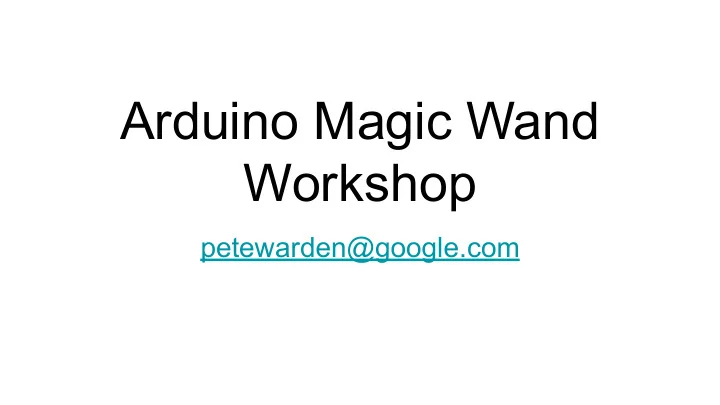

Arduino Magic Wand Workshop petewarden@google.com
Goal By the end of this workshop, you should have programmed your own gesture-recognizing magic wand running on an Arduino! Based on Chapter 11 of TinyMLBook.com
Stretch Goal We’re trying to improve the gesture recognition, so we need more data. I’ll show you how to capture and contribute data from your own gesture attempts.
What You Need - Mac, Linux or Windows laptop - Arduino Nano BLE Sense 33 - MicroUSB cable - Possibly a USB C to USB B converter, if you’re on a USB C laptop - A stick, about 12 inches (30cm long) - Sticky tape
What You’ll End Up With A wand you can wave! It should light up the LED if you wave in a circle, and turn off the LED if you wave it in an L shape.
Step 1 - Unpack your Arduino Remove it from the box. Pull it out of the packing foam. It’s conductive, and can cause problems otherwise! Plug the MicroUSB cable into the socket in the chip. Plug the other end of the cable into a USB socket on your laptop. If you have a newer USB-C laptop, you may need an adaptor. The bottom left LED on the Arduino should light up.
Step 2 - Install Arduino IDE Download the Arduino IDE - https://www.arduino.cc/en/Main/Software Open the Arduino IDE Choose Tools->Board->Board Manager… Search for “mbed” and install “Arduino mbed-enabled Boards” for Nano support
Step 3 - Choose the Board In Tools->Board, select “Arduino Nano 33 BLE” If you see <cstdargs> errors when compiling, check your board selection at the bottom right of the IDE!
Step 4 - Set up the Port In the Arduino IDE, make sure the board is plugged in and that the port shows up. Troubleshooting this is a black art, which varies across Mac, PC, and Linux machines. A good place to start is https://www.arduino.cc/en/Guide/Troubleshooting#toc16 If it works, you should see something like this:
Step 5 - Check the Board Connection Choose Tools->Get Board Info You should see something similar to this:
Step 6 - Install Libraries Download the TensorFlow Arduino Library - https://bit.ly/2HVMKJm Run Arduino, and choose Sketch->Include Library->Add .ZIP Library… Add the TensorFlow Arduino .zip you downloaded. From Sketch->Include->Manage Libraries…, install Arduino_LSM9DS1
Step 7 - Load Example Sketch In the Arduino IDE, you should see Arduino_LSM9DS1 and Arduino_TensorFlowLite at the bottom of the File->Examples menu. If not, go back to step 5 and make sure you’ve installed correctly. Choose the magic_wand entry to load the sample code.
Step 8 - Build the Example Click the upload button in the sketch window If you see compiler errors, then something went wrong with previous software installation steps. After a few minutes you should see red text indicating flashing has completed. During upload, the right LED should pulse, and then go dark at the end.
Step 9 - Assemble the Wand Tape the Arduino securely to your stick, with the cable downwards and the LEDs visible.
Step 10 - Open the Serial Monitor With the USB plugged in, select Tools->Serial Monitor from the Arduino menu. Try waving the wand, you should see some output.
Step 11 - Practice a Gesture Start by holding the wand facing upward, with the LEDs toward you. Move the wand down and then to the right, you should see ‘Slope’ on the monitor. Starting upright, move the wand in a clockwise circle over about one second. You should see ‘Ring’ in the monitor, and the right LED light up.
Step 12 - Gather more data The model needs improvement, which means it needs more data! In the magic_wand sketch, change should_capture_data to true Don’t worry about saving it, just rebuild after the change.
Recommend
More recommend